Search results for: 'mask'
- Related search terms
- mask film packing
- mask+film+packing
-
 How To Choose an N95 Respirator Mask For Coronavirus Prevention? All You Need to Know Before Buying Face Masks
How To Choose an N95 Respirator Mask For Coronavirus Prevention? All You Need to Know Before Buying Face MasksHow To Choose an N95 Respirator Mask For Coronavirus Prevention? All You Need to Know Before Buying Face Masks.
1. What’s an N95 mask?
An N95 respirator is a respiratory protective face mask, designed to help reduce the user’s exposure to airborne particles including very small particles (0.3 microns) and large droplets. N95 respirator face mask literally has a filtration efficiency of at least 95% against non-oily particles.
2. Differences between N95 mask and surgical mask?
Generally, the N95mask also includes an N95 surgical mask. So, here we will just compare a standard N95 particulate mask with a disposable surgical mask. Surgical masks are designed to be worn by healthcare professionals during surgery and nursing, to help prevent contamination of the surgical field or the patient by capturing liquid droplets that are expelled by the user.
An N95 particulate mask blocks at least 95 percent of very small (0.3 microns) test particles, and while a disposable surgical mask is fluid-resistant and protects the user against large particles (5 microns), droplets, sprays or splatter.
Different from a loose-fitting, disposable surgical mask, an N5 mask is tight-fitting to achieve a very close facial fit, which guarantees a minimal leakage around the edges of the mask when the user inhales. If properly fitted, the filtration capabilities of N95 respirators exceed those of disposable surgical face masks.Speaking of the N95 mask price and disposable surgical mask price, the N95 respirator mask is pricier than a surgical mask. In contrast, the N95 mask is reusable but the common surgical mask is disposable. Strictly speaking, N95 respirator masks should be worn for a maximum of eight hours while the disposable surgical mask is recommended to be replaced every four hours.
However, during the novel coronavirus outbreak, face masks are in short supply and everyone discards one or two face masks every day. A surgical mask could be used for a whole day in a good condition of no damage, no moisture, and no deformation. According to some researches, the N95 respirator mask used for two days still maintains a filtration efficiency of at least 95%, while the filtration efficiency of an N95 respirator used for three days reduced to 94.7%. So, if an N95 respirator is in good maintenance, you can wear it for at least 2 days, a week, maybe even a month.
3. Types of N95 mask
Generally, according to their intended use, the types of N95 masks include the standard N95 particulate respirators and N95 surgical respirator masks. Additionally, there are N95 masks with a breathing valve or not.
1) Differences between standard N95 particulate respirator and N95 surgical mask:
How to differentiate standard N95 particulate-filtering respirators and N95 surgical masks? The N95 surgical mask is literally a combination of N95 respirator and surgical mask, it is both certificated by NIOSH as an N95 respirator and also cleared by the FDA as a surgical mask. N95 surgical respirator masks are also referred to as medical respirators, healthcare respirators, or surgical N95s.
The significant difference between a standard N95 particulate respirator and an N95 surgical mask is that the N95 surgical mask is fluid-resistant while the standard N95 particulate respirator is not.
An N95 particulate respirator, also called N95 dust mask or N95 pollution mask, helps reduce very small particles inhaled by the user, and it is used for respiratory protection when the user might be exposed to particulate hazards. With a fluid resistance plus, an N95 surgical mask help reduce particles both inhaled and exhaled by the user, it is designed to be used during surgery and nursing tasks, whatever the user requires respiratory protection, expelled particulates or requires fluid resistance.
2) Differences between N95 masks with a breathing valve or not:
Many people question: Is an N95 mask with an exhalation valve better than the one without a valve?
In fact, the N95 respirators with an exhalation valve are not recommended to be used for coronavirus prevention, because the valve is a one-way vent that couldn’t keep your exhalation to yourself. It means that this valved N95 mask makes your breathing out easier and helps reduce heat build-up to avoid fogging up your glasses, however, it’s not that friendly to others.
Besides, the N95 mask with the valve is pricier than the one without a valve.4. What are the differences between N95, KN95, FFP2, and KF94?
When you search for the N95 respirators, there are many respirators such as KN95, FFP2, and KF94 that appeared in the same breath. What’s different between these respirators of different letters?
Actually, both the N95, KN95, FFP2 and KF94 respirators have almost the same filtration efficiency, it means that KN95, FFP2, and KF94 are as effective as the N95 respirator mask. The main difference between these respirators is that they are tested by different nations.
The N95 mask has a full name of NIOSH-certified N95 respirator, which means these respirators are tested of 95% filtration and certified by the U.S. National Institute of Occupational Safety and Health (NIOSH). The KN95 respirator is a particulate-filtering mask tested using the China criteria. The FFP2 is a filtering facepiece score of 94% filter capacity approved by Europe, and the KF94 is tested by Korea criteria.
To simply put, we could put these respirators into an equation as below:
N100 (99.97%) = FFP3 (99.95%) > N95 (95%) = KN95 (95%) = FFP2 (94%) = KF94 (94%) > KN90 (90%).
Learn More
Anti Virus Flu Mask Meets FFP2 N95 KN95 KF94 Guidance -
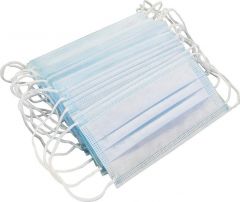 V-1807 AUTOMATIC FACE MASK WITH OUTER EAR LOOP MACHINE, 120 MASKS PER MINUTE, FLAT TYPE
V-1807 AUTOMATIC FACE MASK WITH OUTER EAR LOOP MACHINE, 120 MASKS PER MINUTE, FLAT TYPEI. FUNCTION
Learn More
THE MACHINE IS FULLY AUTOMATIC EAR TO LOOP MASK MAKING MACHINE. THIS MACHINE INCLUDES ONE SET OF CS-175 AND 2 SETS CS-WD175 AND BY A UNIT OF AUTOMATED DISPENSER. MASK BODIES PRODUCED ON THE MASK MACHINE CAN BE ALLOCATED ONTO 2 SETS OF SUBSEQUENT MACHINES CONTROLLED BY PLC AT THE SPEED OF 0 TO 120 PIECES PER MINUTE. ALL OF OPERATIONS OF THE MACHINE ARE CONTROLLED THROUGH TOUCH SCREEN OR PLCS.
II. PROCESS
AFTER THE MACHINE MAKES THE MASK BODY, THE CONVEYOR BELT STRUCTURE TRANSPORTS THE MASK BODY PIECE TO THE CONNECTING CONVEYOR. THROUGH THE CONNECTION CONVEYOR MASK PLATE TO THE CONVEYOR BELT, AGAIN THROUGH THE CONVEYOR BELT THE MASK IS TRANSPORTED TO THE EAR PIECE SECTION TO THE FRONT OF THE MACHINE ABOVE THE FIRST MASK PLATE, FINALLY THROUGH THE CYLINDER DOWN THE MASK ONTO MASK EAR MACHINE DISC, FOLLOWED UP BY EAR MASKS FOR THE EARS OF THE BELT WELDING MACHINE AND THEN IT’S COMPLETE.
III. FEATURES:
1. MACHINE FRAME IS MADE OF ALUMINUM ALLOY, PREVENTED FROM RUST;
2. THE MACHINE CAN MAKE 1 TO 3 TYPES OF MASK BLANKS ACCORDING TO WHAT THE CUSTOMER REQUIRES.
3. THE SIZE OF THE MASK BLANK AND THE FOLDING LOCATION CAN BE ADJUSTED;
4. THE DIRECTION OF THE EAR LOOP IS OUTSIDE;
5. A COMPUTER PROGRAM CONTROL AND PHOTOELECTRIC DETECTION ACHIEVES A HIGH RELIABILITY AND LOW FAILURE RATE. -
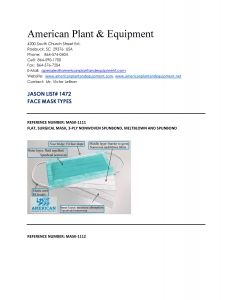 JASON LIST-1472 FACE MASK TYPES
JASON LIST-1472 FACE MASK TYPESJASON LIST# 1472
FACE MASK TYPES
REFERENCE NUMBER: MASK-1111
FLAT, SURGICAL MASK, 3-PLY NONWOVEN SPUNBOND, MELTBLOWN AND SPUNBONDREFERENCE NUMBER: MASK-1112
REFERENCE NUMBER: MASK-1113
REFERENCE NUMBER: MASK-1121
SEE J-2756 FOR THE LINE THAT PRODUCES THESEREFERENCE NUMBER: MASK-1115
KN95 MEDICAL MASKS (PARTICULATE RESPIRATORS)REFERENCE NUMBER: MASK-1116
N95 MEDICAL MASKS (PARTICULATE RESPIRATORS)REFERENCE NUMBER: MASK-1117
FFP2 MEDICAL MASKS (PARTICULATE RESPIRATORS)REFERENCE NUMBER: MASK-1118
3M MODEL 1860 MEDICAL MASKS (PARTICULATE RESPIRATORS)REFERENCE NUMBER: MASK-1119
3M 8577 MEDICAL MASKS (PARTICULATE RESPIRATORS)REFERENCE NUMBER: MASK-1120
3M 9541V MEDICAL MASKS (PARTICULATE RESPIRATORS)REFERENCE NUMBER: MASK-1124
3M 1870 HEALTH CARE PARTICULATE RESPIRATOR & SURGICAL MASKREFERENCE NUMBER: MASK-1122
3M 1860S HEALTH CARE PARTICULATE RESPIRATOR & SURGICAL MASKREFERENCE NUMBER: MASK-1123
3M 1860 HEALTH CARE PARTICULATE RESPIRATOR & SURGICAL MASKMore information is available upon request.
Learn More
E-mail us for price, pictures, video, or diagram.
Include our reference number. -
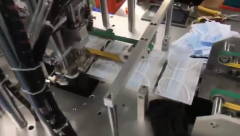 J-2779-B SEMI-AUTOMATIC FACE MASK EAR STRAP WELDING MACHINE, 60 PIECES PER MINUTE -This machine fastens the ear straps to masks only. For mask production, See J-2778
J-2779-B SEMI-AUTOMATIC FACE MASK EAR STRAP WELDING MACHINE, 60 PIECES PER MINUTE -This machine fastens the ear straps to masks only. For mask production, See J-2778SEMI-AUTOMATIC BLANK FACE MASK EAR STRAP WELDING MACHINE
ULTRASONICALLY WELDS EAR STRAPS TO FACE MASK BLANKS
MASK DIMENSIONS: 175 x 95mm
CAPACITY: 60 PIECES PER MINUTE
POWER: 3 KW
DIMENSIONS: 1950mm L x 7000mm W x 1620mm H
WEIGHT: 200 KGSAUTOMATIC FEEDING OF ELASTIC STRAP USED FOR EAR LOOPS
AUTOMATIC CUTTING OFF OF MANUAL LOADING AND UNLOADING
FLEXIBLE CONFIGURATION WITH EASY CONTROLTWO SIZES OF MASKS CAN BE WELDED SIMULTANEOUSLY, SAVING TIME AND LABOR
MANUAL LOADING & UNLOADING
VERY EFFICIENT, LOW FAILURE RATE
WEIGHT OF MACHINE WHEN PACKED FOR AIR FREIGHT : 200 kgs
DIMENSIONS OF MACHINE WHEN PACKED FOR AIR FREIGHT: 2000 x 700 x 1650mmQUANTITY: 1
Learn More -
 J-2779 SEMI-AUTOMATIC FACE MASK EAR STRAP WELDING MACHINE, 20 PIECES PER MINUTE -This machine fastens the ear straps to masks only. For mask production, See J-2778
J-2779 SEMI-AUTOMATIC FACE MASK EAR STRAP WELDING MACHINE, 20 PIECES PER MINUTE -This machine fastens the ear straps to masks only. For mask production, See J-2778SEMI-AUTOMATIC BLANK FACE MASK EAR STRAP WELDING MACHINE
ULTRASONICALLY WELDS EAR STRAPS TO FACE MASK BLANKS
MASK DIMENSIONS: 175 x 95mm
CAPACITY: 15 TO 20 PIECES PER MINUTE
POWER: 2 KW
DIMENSIONS: 1200mm L x 750mm W x 1700mm H
WEIGHT: 350 KGWITH AUTOMATIC FEEDING AUTOMATIC CUTTING OF EAR STRAP MATIERAL
MANUAL LOADING & UNLOADING
FLEXIBLE CONFIGURATION, EASY TO OPERATE
VERY EFFICIENT, WITH LOW FAILURE RATEPACKAGE BY WOODEN BOX: 800 X 1250 X 1600mm
Learn More
TOTAL WEIGHT IS EXPECTED TO BE AROUND 100KGS -
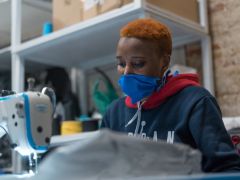 D-2388 What’s the Best Material for a Mask?
D-2388 What’s the Best Material for a Mask?Federal health officials have now recommended that we cover our faces with fabric during the coronavirus pandemic. But what material offers the most protection?
The Centers for Disease Control and Prevention has posted a no-sew mask pattern using a bandanna and a coffee filter as well as a video on making masks using rubber bands and folded fabrics found at home.
While a simple face covering can reduce the spread of coronavirus by blocking outgoing germs from coughs or sneezes of an infected person, experts say there is more variation in how much homemade masks might protect the wearer from incoming germs, depending on the fit and quality of the material used.
Scientists around the country have taken it upon themselves to identify everyday materials that do a better job of filtering microscopic particles. In recent tests, HEPA furnace filters scored well, as did vacuum cleaner bags, layers of 600-count pillowcases and fabric similar to flannel pajamas. Stacked coffee filters had medium scores. Scarves and bandanna material had the lowest scores, but still captured a small percentage of particles.
If you don’t have any of the materials that were tested, a simple light test can help you decide whether a fabric is a good candidate for a mask.
“Hold it up to a bright light,” said Dr. Scott Segal, chairman of anesthesiology at Wake Forest Baptist Health who recently studied homemade masks. “If light passes really easily through the fibers and you can almost see the fibers, it’s not a good fabric. If it’s a denser weave of thicker material and light doesn’t pass through it as much, that’s the material you want to use.”
Researchers say it’s important to remember that lab studies are conducted under perfect conditions with no leaks or gaps in the mask, but the test methods give us a way to compare materials. And while the degree of filtration for some homemade masks seems low, most of us — who are staying home and practicing social distancing in public — don’t need the high level of protection required for medical workers. More important, any face covering is better than none, especially if worn by a person who has the virus but doesn’t know it.
The biggest challenge of choosing a homemade mask material is to find a fabric that is dense enough to capture viral particles, but breathable enough that we can actually wear it. Some items being touted online promise high filtration scores, but the material would be unwearable.
Dressing Up for Work … at Home
Yang Wang, an assistant professor of environmental engineering at Missouri University of Science and Technology, worked with his graduate students to study various combinations of layered materials — including both air filters and fabric. “You need something that is efficient for removing particles, but you also need to breathe,” said Dr. Wang, who last fall won an international award for aerosol research.To test everyday materials, scientists are using methods similar to those used to test medical masks, which everybody agrees should be saved for medical workers who are exposed to high doses of virus from seeing infected patients. The best medical mask — called the N95 respirator — filters out at least 95 percent of particles as small as 0.3 microns. By comparison, a typical surgical mask — made using a rectangular piece of pleated fabric with elastic ear loops — has a filtration efficiency ranging from 60 to 80 percent.
Dr. Wang’s group tested two types of air filters. An allergy-reduction HVAC filter worked the best, capturing 89 percent of particles with one layer and 94 percent with two layers. A furnace filter captured 75 percent with two layers, but required six layers to achieve 95 percent. To find a filter similar to those tested, look for a minimum efficiency reporting value (MERV) rating of 12 or higher or a microparticle performance rating of 1900 or higher.
The problem with air filters is that they potentially could shed small fibers that would be risky to inhale. So if you want to use a filter, you need to sandwich the filter between two layers of cotton fabric. Dr. Wang said one of his grad students made his own mask by following the instructions in the C.D.C. video, but adding several layers of filter material inside a bandanna.
Dr. Wang’s group also found that when certain common fabrics were used, two layers offered far less protection than four layers. A 600 thread count pillow case captured just 22 percent of particles when doubled, but four layers captured nearly 60 percent. A thick woolen yarn scarf filtered 21 percent of particles in two layers, and 48.8 percent in four layers. A 100 percent cotton bandanna did the worst, capturing only 18.2 percent when doubled, and just 19.5 percent in four layers.
The group also tested Brew Rite and Natural Brew basket-style coffee filters, which, when stacked in three layers, showed 40 to 50 percent filtration efficiency — but they were less breathable than other options.
If you are lucky enough to know a quilter, ask them to make you a mask. Tests performed at the Wake Forest Institute for Regenerative Medicine in Winston-Salem, N.C., showed good results for homemade masks using quilting fabric. Dr. Segal, of Wake Forest Baptist Health, who led the study, noted that quilters tend to use high-quality, high-thread count cotton. The best homemade masks in his study were as good as surgical masks or slightly better, testing in the range of 70 to 79 percent filtration. Homemade masks that used flimsier fabric tested as low as 1 percent filtration, Dr. Segal said.
The best-performing designs were a mask constructed of two layers of high-quality, heavyweight “quilter’s cotton,” a two-layer mask made with thick batik fabric, and a double-layer mask with an inner layer of flannel and outer layer of cotton.
Bonnie Browning, executive show director for the American Quilter’s Society, said that quilters prefer tightly woven cottons and batik fabrics that stand up over time. Ms. Browning said most sewing machines can handle only two layers of fabric when making a pleated mask, but someone who wanted four layers of protection could wear two masks at a time.
Ms. Browning said she recently reached out to quilters on Facebook and heard from 71 people who have made a combined total of nearly 15,000 masks. “We quilters are very much in the thick of what’s going on with this,” said Ms. Browning, who lives in Paducah, Ky. “One thing most of us have is a stash of fabric.”
People who don’t sew could try a folded origami mask, created by Jiangmei Wu, assistant professor of interior design at Indiana University. Ms. Wu, who is known for her breathtaking folded artwork, said she began designing a folded mask out of a medical and building material called Tyvek, as well as vacuum bags, after her brother in Hong Kong, where mask wearing is common, suggested it. (DuPont, the maker of Tyvek, said in a statement that Tyvek is intended for medical apparel, not masks.) The folded mask pattern is free online, as is a video demonstrating the folding process. In tests at Missouri University and University of Virginia, scientists found that vacuum bags removed between 60 percent and 87 percent of particles. But some brands of vacuum bags may contain fiberglass or are harder to breathe through than other materials, and shouldn’t be used. Ms. Wu used a bag by EnviroCare Technologies, which has said it does not use fiberglass in its paper and synthetic cloth bags.
“I wanted to create an alternative for people who don’t sew,” said Ms. Wu, who said she is talking to various groups to find other materials that will be effective in a folded mask. “Given the shortage of all kinds of materials, even vacuum bags might run out.”
The scientists who conducted the tests used a standard of 0.3 microns because that is the measure used by the National Institute for Occupational Safety and Health for medical masks.
Linsey Marr, a Virginia Tech aerosol scientist and an expert in the transmission of viruses, said the certification method for respirators and HEPA filters focuses on 0.3 microns because particles around that size are the hardest to catch. While it seems counterintuitive, particles smaller than 0.1 microns are actually easier to catch because they have a lot of random motion that makes them bump into the filter fibers, she said.
“Even though coronavirus is around 0.1 microns, it floats around in a wide range of sizes, from around 0.2 to several hundred microns, because people shed the virus in respiratory fluid droplets that also contain lots of salts and proteins and other things,” said Dr. Marr. “Even if the water in the droplets fully evaporates, there’s still a lot of salt and proteins and other gunk that stays behind as solid or gel-like material. I think 0.3 microns is still useful for guidance because the minimum filtration efficiency will be somewhere around this size, and it’s what NIOSH uses.”
Learn More -
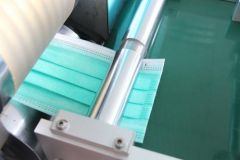 J-2752 FACE MASK PRODUCTION MACHINE – 120 PIECES PER MINUTE
J-2752 FACE MASK PRODUCTION MACHINE – 120 PIECES PER MINUTECOMPOSED OF
FACE MASK BLANK MAKING MACHINE
AUTOMATICALLY PRODUCES THE MAIN PART OF THE MASK
MACHINE HANDLES FEEDING, ALUMINUM STRIP INSERTION, CUTTING, FOLDING, ULTRASONIC WELDING, CUTTING
OUTPUT: 120 PIECES PER MINUTE
VOLTAGE: 220 VOLTS
POWER CONSUMPTION: 2.7 KW
DIMENSIONS: 3345 x 630 x 1830mm
CAN PRODUCE 3 TO 4 DIFFERENT MASK BLANKS ACCORDING TO PRODUCTION REQUIREMENTS
FOLDING LOCATION AND SIZE OF MASK IS ADJUSTABLE
COMPUTER CONTROLS AND PHOTOELECTRIC DETECTION ENSURE LOW FAILURE RATE AND HIGH RELIABILITY
FRAME CONSTRUCTED OF ALUMINUM ALLOY
QUANTITY: 1FACE MASK TRANSFERRING MACHINE
TRANSFERS THE MASKS TO THE ULTRASONIC EAR STRAP WELDING MACHINE
QUANTITY: 1ULTRASONIC EAR STRAP WELDING MACHINE
WELDS THE ELASTICS ON BOTH EDGES OF THE MASK
AUTOMATIC COUNTING
AUTOMATICALLY CONVEYS THE FINISHED MASKS TO PACKING PROCESS (PACKING BY HAND)
COMPUTER CONTROLS AND PHOTOELECTRIC DETECTION ENSURE LOW FAILURE RATE AND HIGH RELIABILITY
FRAME CONSTRUCTED OF ALUMINUM ALLOY
QUANTITY: 2PRODUCES MASKS WITH DIMENSIONS: 175mm x 95mm (ADULT SIZE)
FOR MASK TYPES: 2 LAYERS OF NONWOVEN CLOTH, 3 LAYERS OF NON-WOVEN FABRIC MASKS, 4 LAYERS OF ACTIVATED CARBON MASKS
• 2 LAYER FACIAL MASK: NONWOVEN, ALUMINUM STRIP, EAR STRAP WELDING
• 3 LAYER FACIAL MASK: NON-WOVEN, ALUMINUM STRIP, EARLOOP WELDING, FILTER COTTON (FILTER PAPER)
• ACTIVATED CARBON MASKS: NONWOVEN, ALUMINUM STRIP, EARLOOP WELDING, FILTER COTTON (FILTER PAPER), ACTIVATED CARBON CLOTHTECHNICAL PARAMETERS
OVERALL DIMENSIONS: 6500 L x 4000 W x 2000 H (mm)
PRODUCTION EFFICIENCY: 95%
PRODUCT SIZE: 175 x 95mm (ADULT SIZE)
FACIAL MASK LAYERS: 3 TO 4 LAYERS
POWER: 9 KW
AIR PRESSURE REQUIRED: 0.6 MPA
AIR CONSUMPTION: 300 LITERS PER MINUTE
WEIGHT: APPROXIMATELY 1800 KG
GROUND WEIGHT BEARING: ≤ 500KG/m2
ALL OF THE MAIN DRIVING PARTS ARE PROTECTED BY PROTECTIVE COVERQUANTITY: 1 COMPLETE LINE
Learn More -
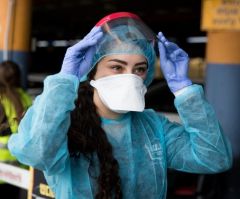 H-2366 MASK AND MEDICAL GOWN LABORATORY EQUIPMENT
H-2366 MASK AND MEDICAL GOWN LABORATORY EQUIPMENTREFERENCE NUMBER: T-6334
Learn More
ALL KINDS OF MASK TESTING INSTRUMENTS
(SURGICAL MASK)
(DISPOSABLE SURGICAL MASK)
(MEDICAL PROTECTIVE MASK)
(DAILY PROTECTIVE MASK)
ITEM 001
COMPREHENSIVE TENSION TESTER FOR SURGICAL MASK
ITEM 002
MASK SYNTHETIC BLOOD PENETRATION DETECTOR
ITEM 003
BACTERIAL PERCOLATION EFFICIENCY (BFE) TESTER
ITEM 004
PARTICLE EFFICIENCY (PFE) TESTER
ITEM 005
RESPIRATOR RESISTANCE TESTER
ITEM 006
MASK FLAME RETARDANT PERFORMANCE TESTER
ITEM 007
FABRIC SURFACE MOISTURE TESTER
ITEM 008
MASK AIR TIGHTNESS TESTER
ITEM 009
TEMPERATURE PRETREATMENT CONSTANT TEMPERATURE AND HUMIDITY CHAMBER
ITEM 010
COLOR FASTNESS TO FRICTION TESTER
ITEM 011
TEXTILE FORMALDEHYDE TESTER
ITEM 012
PH METER
REFERENCE NUMBER: T-6335
RESPIRATORY PROTECTIVE EQUIPMENT & SELF-IMBIBITION FILTER ANTI-PARTICULATE RESPIRATOR TESTING INSTRUMENTS
ITEM 001
FIITRATION EFFICIENCY N CLASS SODIUM CHLORIDE PARTICLES, P CLASS OIL PARTICLES
PARTICLE RATE EFFICIENCY TESTER
ITEM 002
RESPIRATOR RESISTANCE TESTER
ITEM 003
BREATHING VALVE TIGHTNESS TESTER
ITEM 004
AXIAL TENSION TESTER FOR BREATHING BONNET
ITEM 005
AXIAL TENSION TESTER FOR BREATHING BONNET
ITEM 006
MASK FIELD TESTER
ITEM 007
HEADBAND TENSILE TESTING MACHINE
ITEM 008
JOINT PARTS&AXIAL TENSILE TESTING MACHINE
ITEM 009
MASK FLAME RETARDANT PERFORMANCE TESTER
ITEM 010
TEMPERATURE PRETREATMENT CONSTANT TEMPERATURE AND HUMIDITY CHAMBER
REFERENCE NUMBER: T-6336
MEDICAL DISPOSABLE PROTECTIVE CLOTHING TESTING INSTRUMENTS
ITEM 001
WATER PENETRATION RESISTANCE TESTER FOR PROTECTIVE CLOTHING
ITEM 002
MOISTURE PERMEABILITY TESTER FOR PROTECTIVE CLOTHING
ITEM 003
SURFACE MOISTURE RESISTANCE TESTER
ITEM 004
ANTISYNTHETIC BLOOD PENETRANT DETECTOR
ITEM 005
TENSILE TESTER FOR BREAKING STRENGTH AND ELONGATION
ITEM 006
FLAME RETARDANT PERFORMANCE TESTER FOR PROTECTIVE CLOTHING
ITEM 007
FRICTION ELECTRIFICATION TESTER FOR PROTECTIVE CLOTHING (FRENCH LADLE)
REFERENCE NUMBER: T-6337
DISPOSABLE MEDICAL RUBBER INSPECTION GLOVES TESTING INSTRUMENTS
ITEM 001
PLASTIC FILM THICKNESS TESTER
ITEM 002
RUBBER GLOVES TENSILE STRENGTH TESTER
ITEM 003
RUBBER GLOVES WATERPROOF TESTER
ITEM 004
RUBBER GLOVES PRETREATMENT AGING BOX
More information is available upon request.
E-mail us for price, pictures, video, or diagram.
Include our reference number -
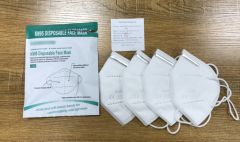 V-1819 KN95 MASKS AVAILABLE FOR SALE, CE CERTIFIED
V-1819 KN95 MASKS AVAILABLE FOR SALE, CE CERTIFIEDSTANDARD: GB2626-2006 KN95
0.3 MICRON PARTICULATE FILTERING > 95%
BUILT-IN ADJUSTABLE SOFT NOSE CLIP
4 LAYERS (4 PLY) IS AVAILABLE NOW
3 LAYERS (3 PLY) CAN ALSO BE MADE
ALL MASKS PASSED CE CERTIFICATIONQUANTITY:
Learn More
4 MASKS PER BAG
160 BAGS PER CARTON = 640 MASKS PER CARTON
350 CARTONS IN A 20 FOOT CONTAINER= 224,000 MASKS PER CONTAINER
WEIGHT AND DIMENSIONS OF ONE CARTON:
GROSS WEIGHT: 5.485 KG
DIMENSIONS: 520mm x 320mm x 480mm -
 J-2765 3-LAYER FACE MASK PRODUCTION MACHINE – 150 MASKS PER MINUTE
J-2765 3-LAYER FACE MASK PRODUCTION MACHINE – 150 MASKS PER MINUTECAPACITY: 100 TO 150 MASKS PER MINUTE
PRODUCES MASKS WITH 3 LAYERS OF POLYPROPYLENE NONWOVEN MATERIAL
AIR PRESSURE: 0.6 MPa, AIR CONSUMPTION 300 LITERS PER MINUTE
CONTROLLED BY PLC, OPERATED BY LCD TOUCH SCREEN
USES ULTRASONIC WELDING FOR EAR STRAPS
VOLTAGE: AS PER CUSTOMER
TOTAL POWER: 11 KW
DIMENSIONS: 6850 x 3520 x 1990mm
WEIGHT: ≤ 5000kgMASK SURFACE LAYER, FILTER LAYER AND BOTTOM LAYER CAN BE ALIGNED AND FED TO THE MACHINE AUTOMATICALLY
BOTH SIDES ARE SYMMETRICAL WITH ULTRASONIC PROCESS STATIONS FOR EAR STRAP WELDING
AFTER WELDING, THE MASKS ARE COUNTED AND PILED TOGETHER AUTOMATICALLY
MASKS ARE DISTRIBUTED EVENLY TO TWO SETS OF EAR STRAP STATIONS BY AUTOMATIC TRANSMISSION SYSTEM, CONTROLLED BY PLC
NOSE CLIPS CAN BE AUTOMATICALLY FED, CUT AND ULTRASONICALLY WELDEDTHE CUP TYPE MASK PRODUCTION LINE CAN BE SENT BY AIR, THERE ARE TOTAL 5 WOODEN CASES, SIZES AND WEIGHT AS BELOW:
1. 2500 X 1100 X 1000mm, 1PC, 250KGS
2. 2200 X 1000 X 1500mm, 1PC, 1100KGS
3. 3000 X 1200 X 1500mm, 1PC, 1100KGS
4. 3000 X 1200 X 1500mm, 1PC, 1100KGS
5. 1900 X 700 X 1150mm, 1PC, 250KGSIF CUSTOMER NEEDS MASK BAGGING MACHINE TO CONNECT WITH DISPOSABLE MASK PRODUCTION LINE, THERE WILL BE ANOTHER TWO WOODEN CASES EXTRA, BUT WILL CANCEL THE FIFTH WOODEN CASE, SIZES AND WEIGHT AS BELOW:
1. 1580mm X 840MM X 1510 mm,1PCS, 340KG
Learn More
2. 2540 mm X 540 mm X 1510 mm,1PCS, 80KG
